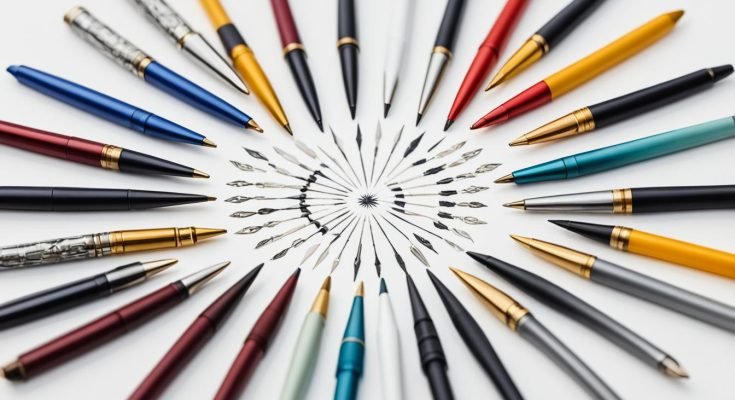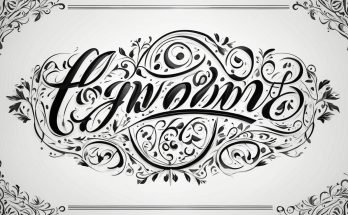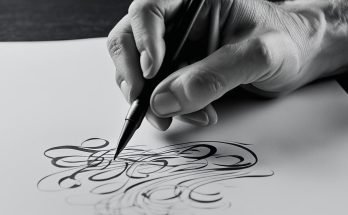Calligraphy Pen Nib Types: Discover the Perfect Nib for Your Artistic Flair
If you’re passionate about calligraphy, then you understand the importance of selecting the right tools for your artistic expression. One essential element of calligraphy pens is the nib type. Calligraphy pen nibs come in a variety of types, each offering its own benefits and artistic effects.
One advantage of using a dip pen is the ability to use a variety of inks, including metallic and glitter inks, as well as homemade inks. This opens up endless possibilities for your creative projects. Dip pens are also easy to clean, allowing you to switch between different nibs for various calligraphy styles effortlessly. Furthermore, dip pens have a lower entry cost, making them an affordable option for beginners and seasoned calligraphers alike.
However, it’s important to note that dip pens do have their drawbacks. They require frequent dipping into ink, which can interrupt the writing flow. Additionally, the nibs need to be prepared before use for optimal performance. There’s also a learning curve associated with dip pens, as they require practice to achieve proper hand position and control writing pressure. Lastly, using dip pens can be a bit messy, so it’s advisable to use them in a designated workspace.
Key Takeaways:
- Calligraphy pen nibs come in a variety of types, offering different writing experiences and artistic effects.
- Dip pens provide a wide range of ink options and flexibility in using different nibs for various calligraphy styles.
- Dip pens have a lower entry cost, making them a cost-effective choice for adding personality to your writing.
- Disadvantages of dip pens include the need for frequent dipping, nib preparation, and a learning curve.
- Using dip pens can result in a messy workspace, so it’s important to have a designated area for calligraphy.
Advantages of Calligraphy Pen Nib Types
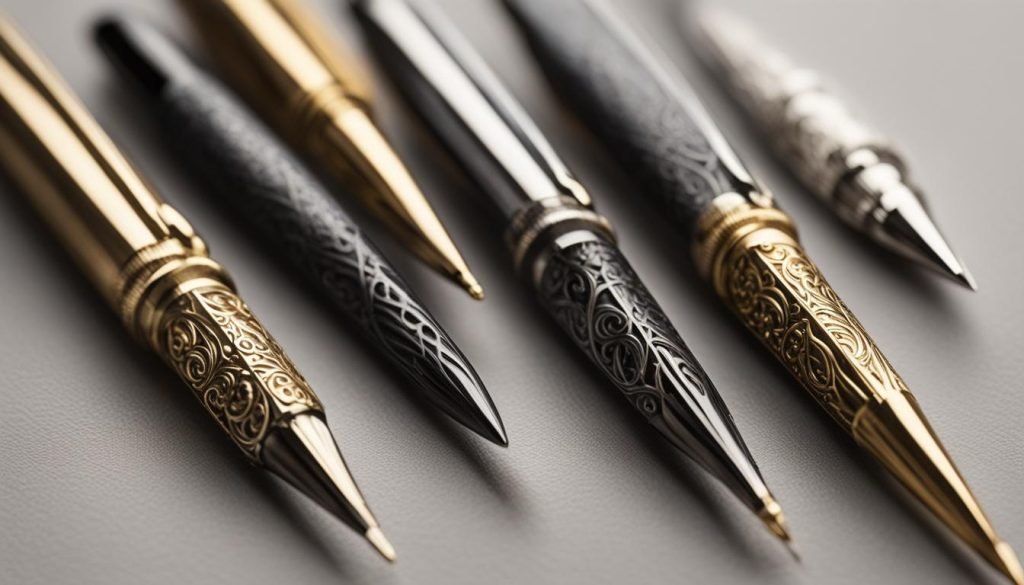
Calligraphy pen nibs offer several advantages that make them a popular choice among beginners and experienced artists alike. Let’s explore these advantages:
- Variety of Inks: Calligraphy pen nibs allow you to explore a wide range of inks, giving you the freedom to experiment and create unique effects in your writing. From vibrant metallic inks to sparkling glitter inks, the possibilities are endless.
- Variety of Nibs: With calligraphy pen nibs, you have a diverse selection of nibs to choose from, each offering different line widths and characteristics. Whether you prefer fine and delicate lines or bold and expressive strokes, there’s a nib type that suits your desired calligraphy style.
- Easy to Clean: Calligraphy pens are designed with removable nibs, making them incredibly easy to clean. You can simply detach the nib from the pen and clean it separately, ensuring optimal performance and longevity.
- Lower Entry Cost: Compared to other writing instruments, calligraphy pen nibs have a lower entry cost, making them a budget-friendly choice for those interested in exploring the art of calligraphy. This affordability allows beginners to start their calligraphy journey without breaking the bank.
| Advantages | Description |
|---|---|
| Variety of Inks | Experiment with different inks and create unique effects |
| Variety of Nibs | Choose from a diverse range of nibs for different line widths and characteristics |
| Easy to Clean | Removable nibs make cleaning a breeze |
| Lower Entry Cost | Budget-friendly option for beginners and artists |
These advantages make calligraphy pen nibs a fantastic choice for anyone looking to add flair and personality to their writing. Whether you’re a beginner or an experienced artist, these versatile tools offer endless possibilities for creativity and self-expression.
Disadvantages of Calligraphy Pen Nib Types
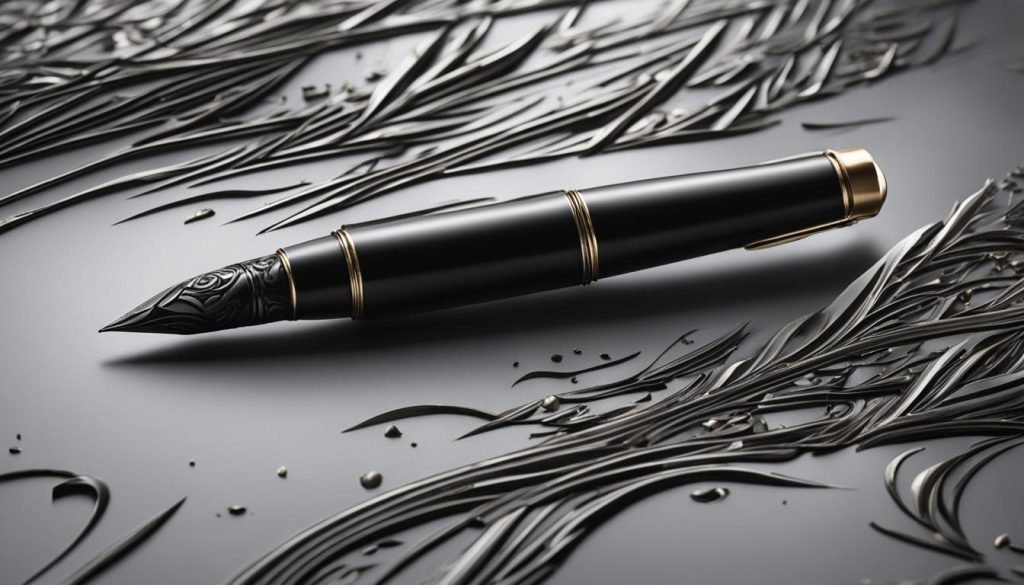
While calligraphy pen nibs offer numerous advantages, it’s important to consider their disadvantages before diving into the world of beautiful lettering. Below are some drawbacks you should be aware of:
1. Frequent Dipping into Ink
One major disadvantage of calligraphy pen nibs is the need for constant dipping into ink. This repetitive action can interrupt your writing flow and become time-consuming, especially when working on lengthy projects.
2. Nibs That Require Preparation
Before you start using a new calligraphy nib, it typically needs to be prepared. This involves removing any machining oils or residues from the nib to ensure optimal performance. This extra step adds to the time and effort required before you can begin your creative endeavors.
3. Learning Curve
Using calligraphy pen nibs comes with a learning curve. Achieving elegant and consistent strokes requires practice and patience as you master the proper hand position and control the pressure you apply. As a beginner, it’s important to be prepared for this initial learning period.
4. Compatibility with Specific Paper
For those who prefer a wetter writing style with their calligraphy pens, it’s important to note that certain papers may not be suitable. Wet writing can lead to issues such as feathering or bleeding of the ink, resulting in a less defined and messy appearance. To ensure optimal results, it’s recommended to use compatible paper designed for calligraphy purposes.
5. Messiness
Using calligraphy pen nibs can get messy, particularly when working on a desk or workspace. The ink may splatter or smudge, requiring additional clean-up and potentially staining your work area. It’s important to have the necessary precautions in place to minimize mess and protect your surroundings.
Choosing the Right Nib Size for Calligraphy
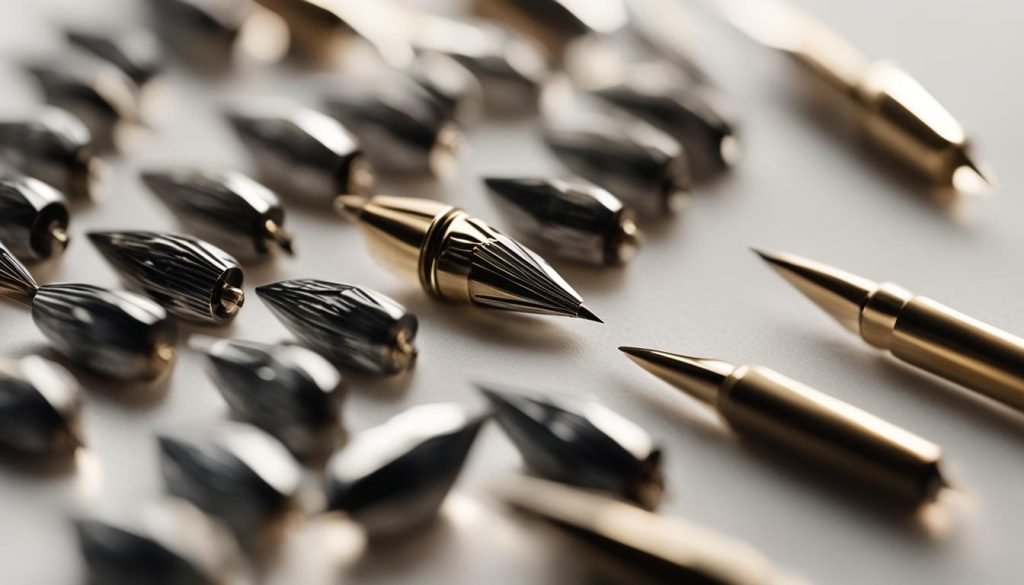
When it comes to calligraphy, choosing the right nib size is crucial for achieving the desired writing style and line variation. Your writing preferences and artistic goals play a significant role in determining the nib size that suits you best. From fine to broad nibs, with the option of stub nibs for added visual interest, there are a variety of nib size options available to explore.
Individuals with small and neat handwriting may find that a fine nib size is ideal for achieving precise and intricate letterforms. On the other hand, those seeking quick and gestural handwriting may prefer a broader nib size that allows for expressive and bold strokes.
It’s worth noting that Japanese nibs tend to run thinner compared to their European counterparts. So, if you prefer a slightly finer line width, you may want to consider Japanese nibs.
To get a better idea of the line width each nib size offers, you can refer to writing samples provided by reputable pen retailers like Goulet Pens. These writing samples allow you to compare the line variation of different nib sizes and make an informed decision based on your writing style and preferences.
By selecting the right nib size for your calligraphy practice, you can achieve the desired balance between letterform precision and expressive strokes. Experiment with different sizes, consider your writing style, and refer to reliable resources to help you find your perfect nib size match.
Understanding Nib Materials: Steel, Gold, and Titanium
Calligraphy pen nibs come in a variety of materials, each offering unique characteristics that can enhance your writing experience. The most commonly used nib materials are steel, gold, and titanium. Let’s explore the qualities and benefits of each:
Steel Nibs
Steel nibs are known for their durability and affordability. They provide a smooth writing experience and are ideal for beginners or those on a budget. Steel nibs also offer flexibility, allowing for line variation and different writing styles. With a steel nib, you can achieve both fine hairlines and thicker strokes in your calligraphy. These nibs are a practical choice for those looking for a reliable, cost-effective option.
Gold Nibs
Gold nibs are highly regarded for their luxurious feel and exceptional smoothness. They offer a softer writing experience, allowing the pen to glide effortlessly across the paper. Gold nibs come in various shapes and sizes, catering to different writing preferences. They provide a level of comfort and control that can enhance your calligraphy. While gold nibs may come at a higher price point, their superior quality and craftsmanship make them a popular choice among serious calligraphers.
Titanium Nibs
Titanium nibs represent a more modern option in the world of calligraphy. They offer a middle ground between steel and gold nibs in terms of both cost and writing experience. Titanium nibs are known for their durability and strength, providing a long-lasting performance. They also offer a unique springy feel, allowing for some degree of line variation. If you’re looking for a nib that combines strength with a touch of flexibility, titanium nibs are worth considering.
When choosing a nib material, it’s important to consider factors such as durability, smoothness, cost, and line variation. Each material brings its own set of benefits, and the decision ultimately comes down to personal preference and budget.
| Nib Material | Durability | Smoothness | Cost | Line Variation |
|---|---|---|---|---|
| Steel | Durable | Smooth | Affordable | Flexible |
| Gold | Delicate | Very Smooth | Expensive | Soft, Responsive |
| Titanium | Durable | Smooth | Moderate | Some Flexibility |
Conclusion
When it comes to calligraphy pen nib types, there is a wide range of options available to suit your individual preferences and desired writing style. Choosing the right nib size and material is crucial and depends on factors such as your handwriting size, writing speed, desired line variation, and personal preference.
Whether you opt for steel, gold, or titanium nibs, each material offers its own unique benefits and considerations. Steel nibs are durable and affordable, providing a smooth writing experience, making them an excellent choice for beginners. Gold nibs offer a softer writing feel and come in a variety of shapes and sizes, allowing for more customization. Titanium nibs, on the other hand, combine strength and springiness, providing a writing experience that falls between gold and steel nibs.
To find your perfect match, don’t be afraid to experiment and try different nib types. Consider how each nib size and material affects your writing experience and line variation. By exploring different nibs and considering your personal preferences, you’ll be able to create beautiful and expressive calligraphy that truly reflects your unique style.
FAQ
What are the advantages of using calligraphy pen nibs?
The advantages of using calligraphy pen nibs include the wide range of inks available for use, allowing artists to experiment and create unique effects. Additionally, there is a variety of nibs to choose from, each offering different line widths and characteristics. Calligraphy pens are also easy to clean, as the nibs can be removed and cleaned separately. Moreover, they have a lower entry cost compared to other writing instruments. These advantages make calligraphy pen nibs a great choice for beginners and artists looking to add flair to their writing.
What are the disadvantages of using calligraphy pen nibs?
Despite their advantages, calligraphy pen nibs also have some disadvantages to consider. They require frequent dipping into ink, which can interrupt the writing flow. Additionally, the nibs need to be prepared before use, as they may have machining oils that affect their performance. Using calligraphy pen nibs also has a learning curve, as writers need to practice proper hand position and control writing pressure. Furthermore, the wet writing of calligraphy pens may require special paper to prevent feathering or bleeding of the ink. Lastly, using calligraphy pen nibs can get messy, especially when using them at a desk or workspace.
How do I choose the right nib size for calligraphy?
When choosing the right nib size for calligraphy, it’s important to consider your writing preferences and desired line variation. Nib size options typically range from fine to broad, with some pens also offering stub nibs for added visual interest. Fine nibs are suitable for those with small and neat handwriting, while broad nibs are more ideal for quick and gestural handwriting. It’s also worth noting that Japanese nibs tend to run thinner than their European counterparts. To get an idea of the line width each nib size offers, websites like Goulet Pens provide writing samples for comparison.
What are the different nib material options for calligraphy pens?
Calligraphy pen nibs are available in various materials, including steel, gold, and titanium. Steel nibs are durable, inexpensive, and offer a smooth writing experience. They are a great option for beginners and come in flexible options for added line variation. Gold nibs, although more expensive, provide a softer writing experience and are available in a variety of shapes and sizes. Titanium nibs, a more modern option, fall between gold and steel nibs in terms of cost and writing experience. They are stronger than gold and offer a springy writing feel with some line variation.
What are the main types of calligraphy pen nibs?
The main types of calligraphy pen nibs include the fine nib, broad nib, flex nib, italic nib, oblique nib, left-handed nib, pointed nib, and chisel nib. Each type of nib offers a unique writing experience and results in different line widths and styles. It’s important to experiment with different nib types to find the one that suits your individual preferences and desired writing style.
What are the advantages of using a dip pen for calligraphy?
The advantage of using a dip pen is the ability to use a variety of inks, including metallic and glitter inks, as well as homemade inks. Dip pens are easy to clean and provide flexibility in switching between different nibs for various calligraphy styles. However, they require frequent dipping into ink, and the nibs need to be prepared for optimal function. Dip pens also have a learning curve and can be messy to use. Despite these disadvantages, dip pens are a cost-effective way to add personality to your writing and have a vintage appeal.
Can calligraphy pen nibs be used with different types of paper?
Yes, calligraphy pen nibs can be used with different types of paper. However, it’s important to consider the wetness of the ink and the need for compatibility with the paper to prevent feathering or bleeding. Specialized calligraphy paper or heavier weight papers are often recommended for the best results. It’s worth experimenting with different papers to find the one that works best for your specific calligraphy needs.

